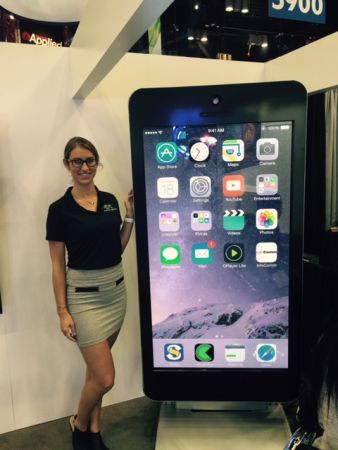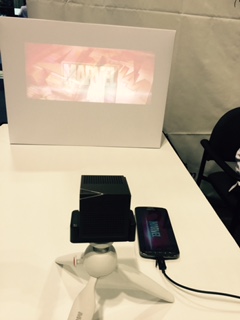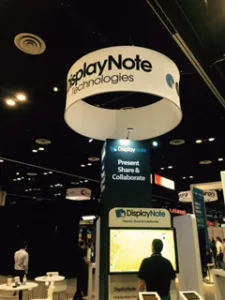I’ve been an educational technology director for 25 years, with a significant track record in large educational technology and AV purchases. I just returned from walking every aisle of Infocomm 2015, poking my head into corners it certainly didn’t belong in.

Education Perspectives
I was searching for promising trends, developments and products that might offer value for the education market. What does an educator see? I look for both memes that make sense in education as well as the practical solution: the product that potentially meets a need or solves a pain somewhere in my organization. Something crisply new and eye-catching can also spark a burgeoning idea in an educator’s mind.
The Memes
Device Sharing. Collaborative display tools were to be seen at InfoComm 2015 just about everywhere. Products like Cynap from WolfVision, which is defined as a “BYOD collaboration system”, is an example. It’s a multimedia interface allowing users to share information in any format, from any device, to any device or location, at any time, including 4k UHD output. These were everywhere in the aisles of the exhibit hall. Educator’s eyes: We see the need for them, too, in education. But vendors suggest that the idea of e-collaboration is easy; a technological slam dunk. It isn’t. Firms selling these products to the K-20 educational market had better get ready for lots of slow scaling, slowly administered pilot sites, and painstaking technical hand-holding. A plethora of ‘gotchas’ awaits, like performance, integration, device limits, bandwidth constraints, a steep learning curve, installation poltergeists, device Babylon and more.
Device sharing solutions and vendors like the Irish firm DisplayNote were everywhere at Infocomm 2015
Huddle Spaces. Even more widespread than the collaborative display tool meme, was the huddle space meme. These solutions, each one a symbiont* for combining with display technology, were seen everywhere and then some. Educator’s eyes: We see similar growth and interest in the education sphere, but this will require treatment in a separate article. For now, simply note that this is a great sell to educators.
 Large and mobile displays were featured in more than a dozen “huddle spaces” exhibits throughout Infocomm 2015
Large and mobile displays were featured in more than a dozen “huddle spaces” exhibits throughout Infocomm 2015
Everything Connected. Anything can talk to everything. Or is it the other way around? This was a clear trend throughout the hall. Take for example Panasonic’s Connected Campus platform. Panasonic, along with other leading companies, is forging a range of solutions to link interactive displays, safety systems, video systems, signage, classroom instructional tools, and communications technology with seamless stitching. Educator’s eyes: We see the emergence of this trend, too, in education. But again, vendors seem to suggest, steeped in their marketing-speak enthusiasm, that the idea of all things connected is easy; another technological slam dunk. It isn’t. Again, firms selling these products to the K-20 educational market had better get ready for lots of hard lifting and the same ‘gotchas’ described above.
Interactive Touch Displays. Interactive touch displays were the royal court favorites in appealing to educators. Their presence was ubiquitous. Like the smartboard craze of years past. Educator’s eyes: In a Panasonic educators’ briefing, a group of university educators were asked about their commitment to this new technology. The response was rather negative, citing a history of unrealized expectations and years of expenditure followed by non-use. No sale here. Not today. For some insight on the interactive display market, see my previous articles, Large Displays and the Educational Market 1 and Large Displays and the Educational Market 2
Commitment to the Education Market. This year I noticed that a number of companies evidenced a solid commitment to education through product enhancement (TCO and other appealing features), product focus (products aimed at K-20), or booth floorspace. Their major commitment to education was palpable. They are paying attention to us. Educator’s eyes: Still, some companies have the education market in mind only as anafterthought, offering a mere foothold. We can tell.
The Fun and the Practical
 Padzilla is bigger than life
Padzilla is bigger than life
Padzilla. It’s big. Really big. Crunchy has released Padzilla, a giant iPhone and iPad interactive display. Now in use in several community colleges, Padzilla is a supersized touch iPhone and iPad that brings mobile learning (I really can’t believe what I am saying) to the front of the classroom. Teachers can demonstrate apps or conduct lessons on this gargantuan device; students can come up and demonstrate solutions to problems, conduct app walkthroughs, or give presentations; or class members can link to the behemoth display via a special app and demonstrate work done on their own iPhone, but on the larger display. I want one.
 The UO Smart Beam Laser Pico Projector
The UO Smart Beam Laser Pico Projector
UO Wired/Wireless Pico Projector. Labeled “the world’s smallest laser projector”, the UO Smart Beam Laser Projector suggests the ultimate portability (plug in or two-hour battery life) for indoor or outdoor projection. I have seen many pico projectors, and I own one, so the reason this caught my attention is that it puts the ‘p’ in pico. I have always had my eye on small and portable projectors for education. Here are some reasons why: first, many teachers don’t have dedicated classrooms. Called “travelling teachers”, these folks have a need for portable and lightweight projectors when not every classroom has a mounted projector. Second, picos are worthy back up projectors; when things go awry (filter, bulb, connections), I can always pull out my eensy-teensy backup pico. Last, outdoor projection with a small class or group at the K12 or university level is something that really sounds incongruous and fun. That’s me. – Len Scrogan
*symbiont – one of the two organisms in a symbiotic relationship

